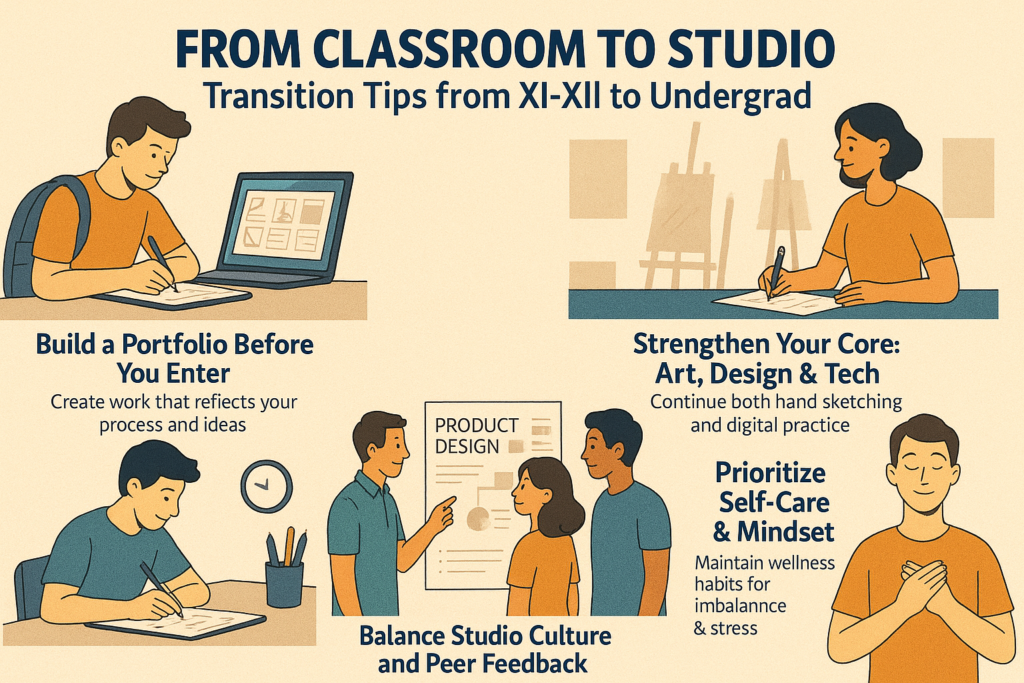
Opening Up The World of Design
The transition from high school to a specialized design and architecture school can be exciting and complicated at the same time. This is the case for Class XI-XII students, droppers, or even early undergrads at Design Aspirants. This shift requires a lot more than just raw talent – it requires a plan, a mindset, and the right kind of support.
1. Start building your portfolio long before entering a design studio.
Create a portfolio that showcases the entire process of your work, from the concept sketches to the finished pieces. This is in line with our widely appreciated DIY Portfolio guide for NIFT aspirants and ensures a smooth start for you.
2. Strengthen your core skills: art, design and technology
- Continue to improve your technical drawing and hand sketching skills you practiced in class XI and XII.
- Make sure you are comfortable with digital tools. Even free software like Inkscape or Affinity can work wonders, as one Redditor clearly recommends. “Get the Affinity programs … Do the weekly sharpen.design projects … Build a portfolio web site …” reddit.com
- Explore workshops or online courses during school vacations
3. Master Multitasking and Assignments Time Management
In design studios, students must tackle series of multi-week projects, which are substantially more difficult than school assignments. The workload in a university is comparable to what is discussed in Central Michigan University’s “7 tips” for being ready for college cmich.edu:
- Try to reach at least 3 hours of studying for each hour of being in class
- Track and plan your project milestones with a calendar or to do list application
- Account for adequate time for research, sketching, critiques, and presentation preparation
4. Participate in the Studio Culture and Peer Assessment
- Find your contemporaries and alumni in the orientation sessions and open studio workshops
- Get in a peer review group as soon as you can; it is a noteworthy boost for your skills and self esteem
- Actively participate in events held by Design Aspirants like “AI & Creativity” to start networking ahead of classes
5. Integrated Basic and Advanced Learning
Your school curriculum gave you a solid start, but it is time to blend:
- Core subjects: design thinking, colour theory, design history
- Specializations: NATA/B.Arch – architectural design; NIFT/NID – product and visual communication design; UCEED/CEED – visualization and cognitive skills
Turn to our comprehensive coaching pages to see how starters build on foundations like IIT-UCEED prep strategies.
6. Utilize Resources Mentorship, Tools, and More
Utilize every form of support:
- Equipment & studio access: Make sure to have all the necessary tools like pencils, sketchbooks, colors, and a laptop with software.
- Seniors and Mentors: Book sessions with seniors through Design Aspirants’ mentoring programs.
- CEED, UCEED, NATA mock tests and past papers: Crucial for all of these tests. We have them on our blog and pitching sessions.
7. Self-Care & Mindset
Challenging and straining studio sessions can take a toll on you. So:
- Daily timed sketch practice.
- Regular nutrition and sleep hygiene.
- Stress and motivation: build a positive peer support network.
- Wellness workshops for design aspirants (coming soon!).
Your 30-Day Transition Checklist
| Week | Focus Area | Action Item |
|---|---|---|
| 1–2 | Portfolio + Sketching | Update/display existing work |
| 1–4 | Tools + Learning | Learn basic Affinity/Inkscape tutorials |
| 2–4 | Study Organization | Create schedules & mock time-tables |
| 3–4 | Community Engagement | Join critique circles & mentoring |
| Ongoing | Self-Care | Daily sketch, proper sleep, reflection journaling |
In Summary
Shifting from XI-XII or a pre-college, school phase to a studio undergraduate program is “life-changing”—as long as you:
- Start developing a robust portfolio in advanced.
- Master design in both their analog and digital forms.
- Develop and adopt appropriate study and time management skills.
- Participate actively in community and feedback processes.
- Strike a healthy balance between specialization and a multidisciplinary approach.
- Utilize and maximize what’s at their disposal while taking care of their health and wellness.
At Design Aspirants, we’ve guided over 1,500 students through this transition. We are ready to guide you. For NIFT, UCEED, CEED, NATA, and B.Arch prep, explore our blog posts and free resources, starting with:
